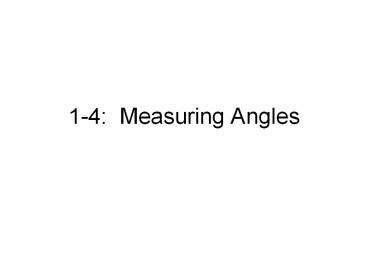1-4: Measuring Angles - PowerPoint PPT Presentation
1 / 13
Title:
1-4: Measuring Angles
Description:
1-4: Measuring Angles Parts of an Angle An angle is formed by two rays with the same endpoint. The rays are the sides of the angle and the endpoint is the ... – PowerPoint PPT presentation
Number of Views:519
Avg rating:5.0/5.0
Title: 1-4: Measuring Angles
1
1-4 Measuring Angles
2
Parts of an Angle
- An angle is formed by two rays with
the same endpoint. - The rays are the sides of the angle and the
endpoint is the vertex of the angle. - The interior of an angle is the
region containing all points
between the sides of the angle. - The exterior of an angle is the region containing
all points outside the angle.
3
Naming an Angle
- You can name an angle by its vertex (?A), a point
on each ray and the vertex (?BAC or ?CAB), or a
number (?1). - Note When using 3 points to name an angle, the
vertex must go in the middle!
4
Naming Angles
- What are two other names for ?1?
- What are two other names for ?KML?
5
Measuring Angles
- One way to measure the size of
an angle is in degrees. - To say that the measure of ?A
is 62?, you would write m?A 62?. - Protractor Postulate Consider OB and point A on
one side of OB. Every ray of the form OA can be
paired one to one
with a real
number
from 0 to 180.
6
Types of Angles
- You can classify angles according to their
measures.
Symbol for right angle!
7
Measuring and Classifying Angles
- What are the measures of ?LKN, ?JKL, and ?JKN?
- Classify each as acute, right, obtuse, or
straight.
8
Congruent Angles
- Angles with the same measure are congruent
angles. - This means that if m?A m?B, then
?A ? ?B (and vice versa). - You can mark angles with arcs to show they are
congruent.
9
Using Congruent Angles
- Synchronized swimmers form angles with their
bodies. - If m?GHJ 90?,
what is m?KLM? - If m?ABC 49?,
what is m?DEF?
10
? Which angle is congruent to ?WBM?
11
Angle Addition
- Angle Addition Postulate If point B is in the
interior of ?AOC, then
m?AOB m?BOC m?AOC.
12
Using the Angle Addition Postulate
- If m?RQT 155?, what are m?RQS and m?TQS?
13
? If m?ABC 175?, what are m?ABD and m?CBD?































